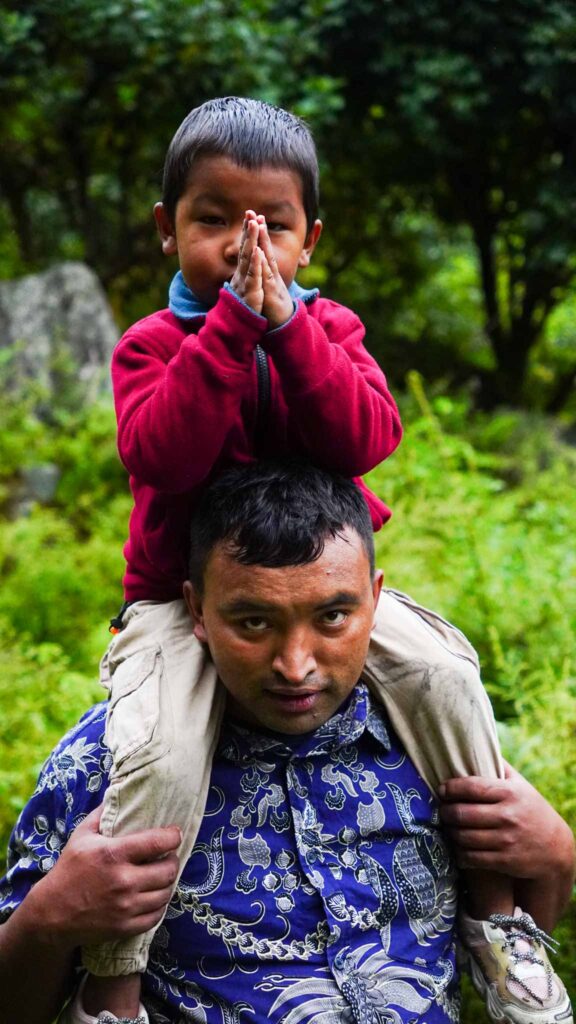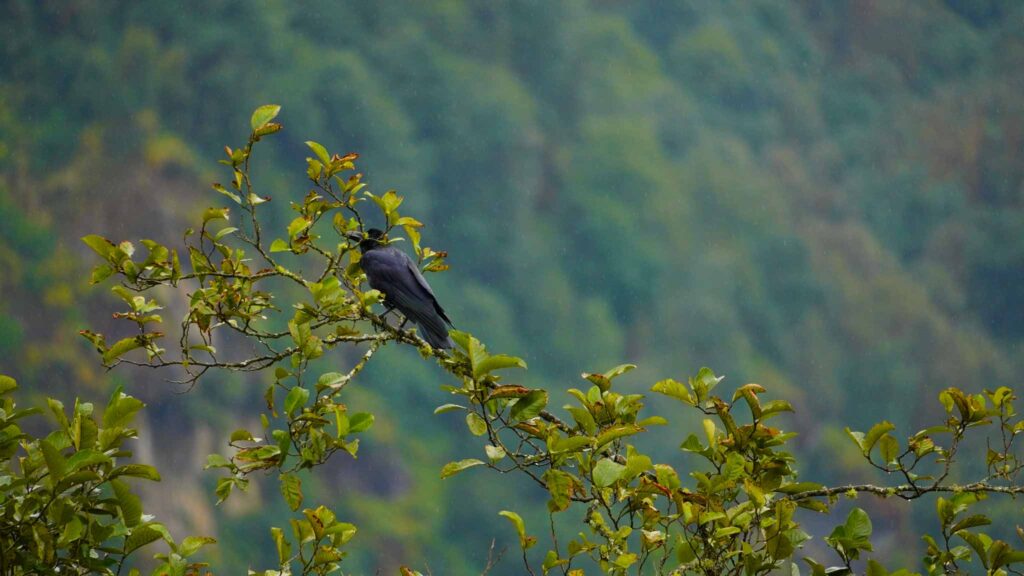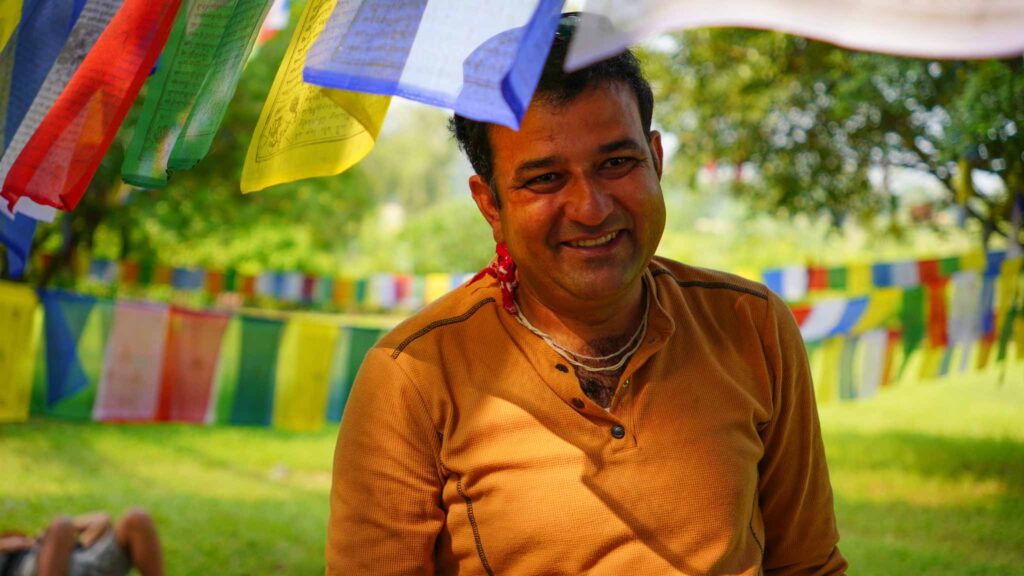
Nepal is a country with vast diversity and endless beauty, from the world’s highest peaks in the north to the flatlands filled with rice cultivation in the south. We spent 44 days there traveling with our Nepali friend Devi and so were able to experience the country from his perspective. We traveled as far East as the foothills of Fikkal where they’re known for their tea production and as far West as Tumlingtar, one of the gateways into the Himalayas. We traveled by local bus covering great distances on windy, often unpaved roads and rode close to 1000 kilometeres on motorcycles. We got used to having dirt in our hair and teeth, the yellowish-orange color of cumin in our fingernails from eating like the locals, with our hands. We learned to hold our breaths as local buses flew passed us spewing their black exhaust, kicking up road dust and often cutting so far into our lane that we were forced into the shoulder to avoid a collision. At first Nepal, especially Kathmandu, is a whirlwind of noise and activity. The capital is home to millions of people living lives at the crossroads of Indian and Western culture, of past traditions and future ambitions. The sounds of engines roaring, incessant honking, the smashing and clinking of businesses and police whistles fill your ears during the day. The morning quiet is broken by the cooing of pigeons, the dainty ringing of handheld prayer bells, the muted trumpeting of the Hindu prayer conch and people praying. Even deep into the neighborhoods there are vendors walking around with loudspeakers announcing their fruits, vegetables, dairy or whatever else they have strapped to their old bicycles. The city is amazing and complex with its fair share of grit as well. The streets often have trash built up and burning on sidewalks and along the river banks. There are wild dogs roaming in packs, though surprising friendly, and they can be heard calling to each other both day and night.

After some time the constant noise faded into the background and crossing a street filled with thousands of cars and motorcycles became second nature. Once you’ve found comfort among the chaos the country really begins to come alive. The markets are filled with colorful clothing, shiny copper and brass pots and handcrafted pottery. You can find every variation of the Buddha and many Hindu gods carved out of wood and stone. Our favorite were the Mandala’s, colorful and intricate to take home and enhance your walls and spirit. The food is earthy, spicy and flavorful. Dahl baht is a staple of the cuisine (lentils and rice) and is usually served with roti (flat bread) and yogurt; and then there are countless sides. The pickled vegetables were new for us and every dish was absolutely packed with flavor. Sometimes sour, sweet or spicy it was always a delight to try something new. Other sides included various types of beans and vegetables cooked in an array of spices like cumin, cardamom, turmeric and cloves. We enjoyed taking the various sides and stirring them into the rice with a twist of the wrist to create one big, delicious mixture.

Nepali’s love to celebrate. They dance and sing and most often with the absence of alcohol. We celebrated Dashai in Dharan, dressing in traditional Nepali clothes, dancing, singing, eating and participating in age old traditions from one town to the next. We also celebrated Nepal’s biggest holiday, Tihar, in Kathmandu and we were welcomed to participate as members of the family. The family and religious traditions were beautiful to witness. There are many ceremonies that family members take part in and offer respect and love in both directions along the generational lines. There is color everywhere from the clothing, the tikka (colored mixture placed on your forehead as a blessing) the decorations and the food and music fills the home from morning to night. We sat in circles on the ground playing card games for hours on end while the television sat lifeless in the corner as it often does here.

The main reason people visit Nepal is for the Himalayas, in fact it is those mountains that initially brought us here as well. We hired an amazing guide, Mingma Temba Sherpa, to show us his world and it wouldn’t be an exaggeration to say that we were in constant awe of our surroundings. Our journey took a turn when the “most dangerous airport in the world,” Hilary Tenzing was socked in with fog. There were hundreds of trekkers sitting around and waiting for clear skies but due to the tight timelines of my Dad and eldest brother we decided to immediately switch plan and head to Poon Hill in Western Nepal. Trekking in the Himalayas is as much a cultural event as it is an active one. You pass through villages and directly in front of peoples’ homes. It was such a special experience to witness people washing clothes and dishes, drying out spices, tending to their livestock and gathering grasses for basket-making. The homes are most often made of wood and though primitive in their construction, are decorated with hand-carved eaves and balustrades. They are usually colored with paint and traditional Buddhist prayer flags, a hallmark of the Himalayas. These flags are blessed by Buddhist monks and hung at certain times of the year to watch over the countless guides and trekkers in those mountains. This year alone 11 people died in a single avalanche, one of which was our guide Mingma’s long time friend. I’ve hiked for many years now and have tremendous respect for mother nature, she has unbounded beauty but is equally unforgiving.

The rhododendron forests were our biggest surprise. The environment was wet and humid, rivers and waterfall echoing through the canyons. The rhododendrons were covered in moss and other growth and unlike most trees with leaves growing only from branches, these trees has leaves spouting from both branch and trunk; as if bursting with life the tree cannot contain its own desire for growth! The forest floor was held together tightly by roots systems grasping the ground and covered in ferns and other low growing grasses. Moss covered rocks and water flowed everywhere all heading south into Nepal’s great river system. After a few days we made it to the viewpoint at Poon Hill where we arrived just as the sun was setting. It was our first time witnessing the majesty of the Himalayas from up close and it was something we will never forget. The high peaks are breathtakingly beautiful and the thought of paying them a visit either attracts or repels your spirit right away. We were lucky that the clouds which were there just 30 minutes prior had cleared out and offered us 180 degree views of the ridgeline.














































